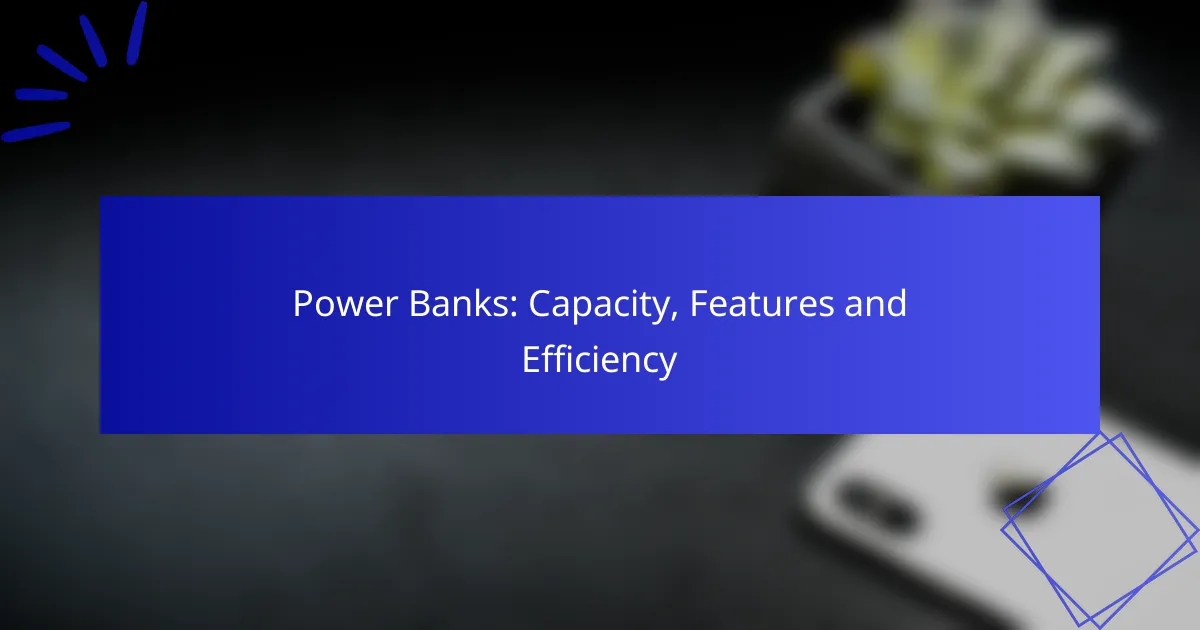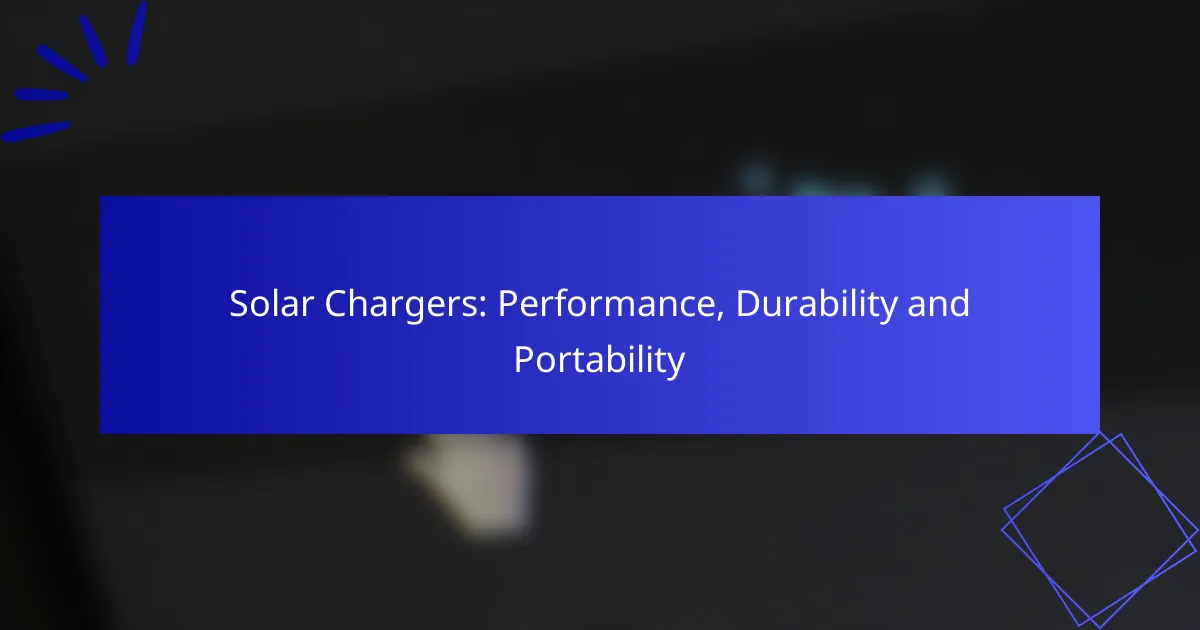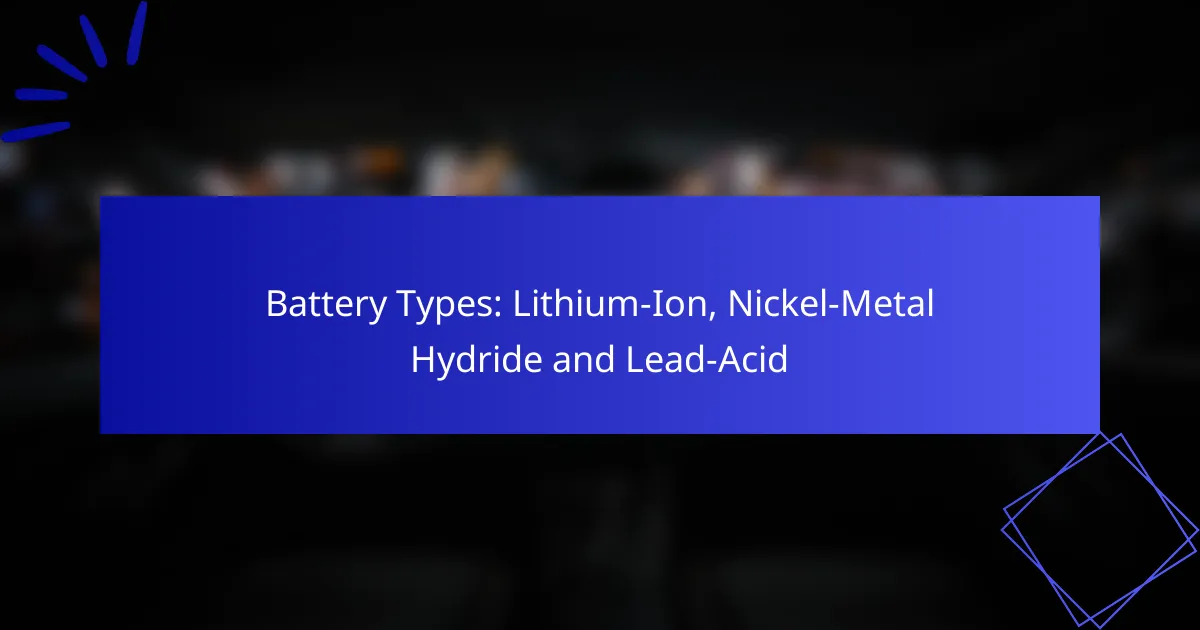Power banks have become essential gadgets for keeping our devices charged while on the go, with capacities often exceeding 20,000mAh for high-performance models. When choosing a power bank, it’s important to consider not only its capacity but also features like charging speed, the number of output ports, and portability, as these can greatly enhance your charging experience. Understanding the mAh rating helps you gauge how many times your devices can be charged before the power bank itself needs recharging.

What are the best power banks for high capacity?
The best power banks for high capacity typically offer over 20,000mAh, providing multiple charges for devices like smartphones and tablets. When selecting a high-capacity power bank, consider factors such as charging speed, number of ports, and overall portability.
Anker PowerCore 26800mAh
The Anker PowerCore 26800mAh is a top choice for those needing substantial power on the go. It features three USB ports, allowing for simultaneous charging of multiple devices, and can fully charge most smartphones several times before needing a recharge itself.
This power bank supports fast charging technology, which can significantly reduce the time required to recharge your devices. Its compact design, despite its high capacity, makes it relatively easy to carry in a bag.
RAVPower 26800mAh
RAVPower’s 26800mAh power bank is another excellent option, known for its robust build and reliability. It also includes three USB ports and supports fast charging, making it efficient for users with multiple devices.
One of its standout features is the ability to recharge itself quickly, often in just a few hours. This means less downtime for both the power bank and your devices, making it a practical choice for travelers.
Zendure A3 10000mAh
The Zendure A3 10000mAh power bank is ideal for users who prefer a smaller, more portable option without sacrificing performance. While it has a lower capacity than the previous models, it still offers enough power to charge most smartphones two to three times.
This power bank is designed to withstand rough handling, making it suitable for outdoor activities. Its lightweight design and durable exterior ensure that it can be easily carried without fear of damage.
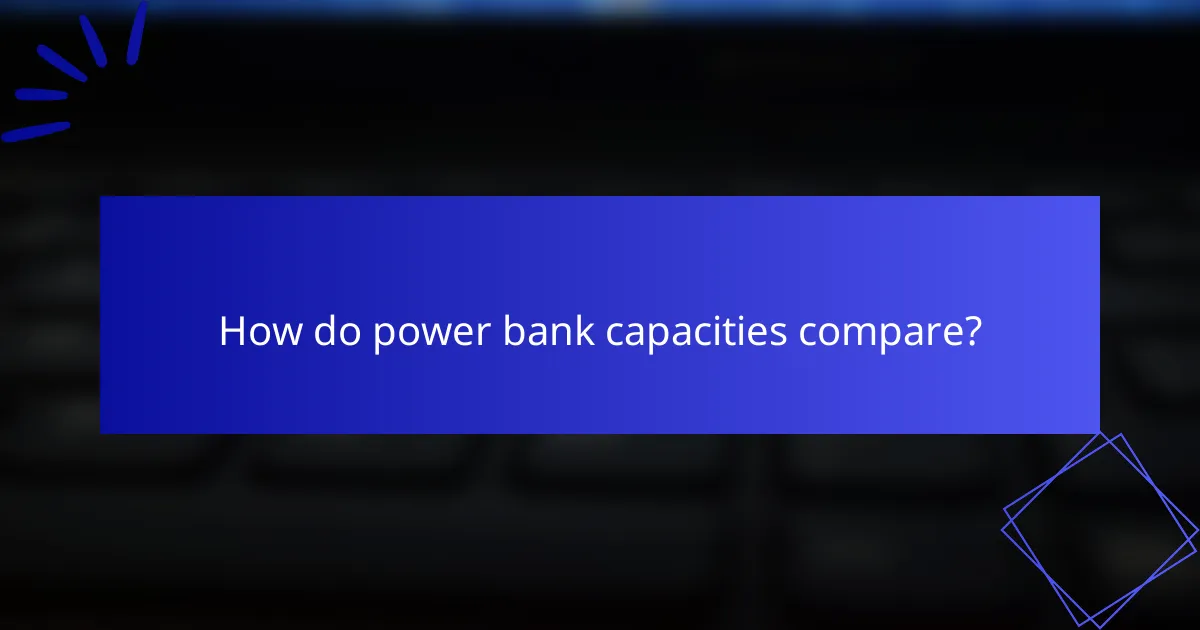
How do power bank capacities compare?
Power bank capacities are typically measured in milliampere-hours (mAh), indicating how much energy they can store. Higher mAh ratings generally mean a power bank can charge devices more times before needing a recharge itself.
mAh ratings explained
The mAh rating of a power bank reflects its total energy storage capacity. For example, a power bank with a capacity of 10,000 mAh can theoretically charge a smartphone with a 2,500 mAh battery about four times, assuming no energy loss. However, actual performance can vary due to factors like conversion efficiency and device compatibility.
It’s important to note that not all mAh ratings are equal. Some power banks may have higher capacities but lower efficiency, meaning they deliver less usable power to your devices. Look for power banks with a high efficiency rating, ideally above 80%, to ensure you get the most out of your investment.
Real-world usage examples
In practical terms, a 5,000 mAh power bank is suitable for charging smaller devices like Bluetooth headphones or smartwatches. A 10,000 mAh power bank is a versatile choice for smartphones, providing multiple charges while remaining portable. For heavy users or those with tablets, a 20,000 mAh or larger power bank is recommended to ensure sufficient power throughout the day.
When selecting a power bank, consider your typical usage patterns. If you often travel or spend long hours away from power sources, investing in a higher-capacity model can be beneficial. Always check the power bank’s output specifications to ensure it meets the charging needs of your devices efficiently.

What features should I look for in a power bank?
When selecting a power bank, consider features such as fast charging capabilities, multiple output ports, and size and weight. These factors can significantly impact the efficiency and convenience of charging your devices on the go.
Fast charging capabilities
Fast charging capabilities allow a power bank to deliver higher wattage, reducing the time it takes to charge devices. Look for power banks that support standards like Quick Charge or Power Delivery, which can charge compatible devices significantly faster than standard USB charging.
For example, a power bank with a 18W output can charge a smartphone from 0% to about 50% in around 30 minutes, compared to a standard 5W charger that may take over two hours for the same task. Always check if your devices support these fast charging technologies to maximize efficiency.
Multiple output ports
Having multiple output ports on a power bank allows you to charge several devices simultaneously. This feature is particularly useful for users with multiple gadgets, such as smartphones, tablets, and wearables.
Look for power banks that offer a combination of USB-A and USB-C ports, as this versatility can accommodate a wider range of devices. A power bank with at least two output ports is ideal for sharing power with friends or charging multiple devices during travel.
Size and weight considerations
Size and weight are crucial factors when choosing a power bank, especially for portability. A compact and lightweight power bank is easier to carry around, making it more convenient for daily use or travel.
Generally, power banks with a capacity of around 10,000mAh strike a good balance between portability and power. They typically weigh between 200g to 300g, making them manageable for most users. However, larger capacity models (20,000mAh or more) may be heavier but can charge devices multiple times before needing a recharge themselves.
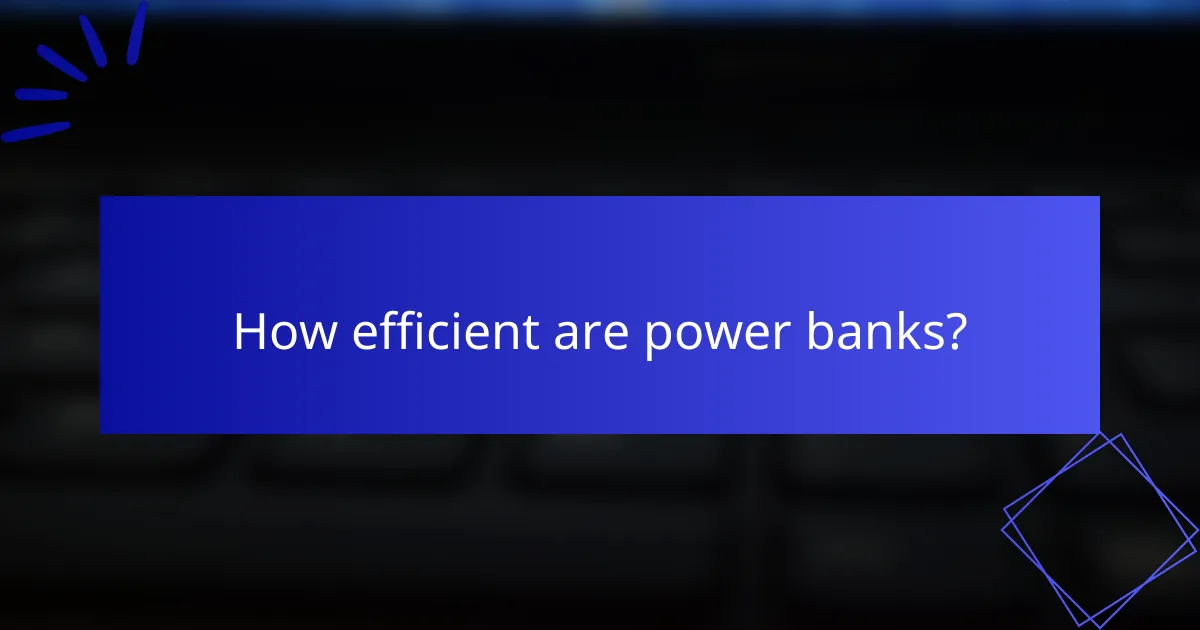
How efficient are power banks?
Power banks typically have an efficiency rating between 70% and 90%, meaning they convert a significant portion of their stored energy into usable power for devices. Factors such as energy conversion rates and the age of the battery can greatly influence this efficiency.
Energy conversion rates
Energy conversion rates refer to how effectively a power bank transfers its stored energy to a device. Most power banks operate with an efficiency of around 80% to 90%, but this can vary based on the quality of the components used. Higher-quality power banks often feature advanced circuitry that minimizes energy loss during charging.
When using a power bank, keep in mind that the output voltage and current can affect conversion rates. For example, a power bank with a 5V output may be more efficient for devices designed to charge at that voltage compared to those requiring higher voltages.
Impact of battery age on efficiency
The age of a power bank’s battery can significantly impact its efficiency. As batteries age, their capacity diminishes, leading to lower energy output and increased internal resistance. This degradation can result in efficiency dropping to as low as 60% in older units.
To maintain optimal efficiency, it is recommended to replace power banks every few years, especially if they show signs of reduced capacity or charge retention. Regularly checking the health of the battery can help ensure that you are getting the most out of your investment.

What are the top brands for power banks in the US?
The leading power bank brands in the US include Anker, RAVPower, and Belkin. These companies are recognized for their reliable performance, innovative features, and wide range of capacities to suit various needs.
Anker
Anker is often regarded as a top choice for power banks due to its extensive product lineup and reputation for quality. Their power banks typically feature high-capacity batteries, fast charging technology, and multiple ports for simultaneous device charging.
When selecting an Anker power bank, consider the capacity you need, which can range from 5,000 mAh for small devices to over 26,000 mAh for larger gadgets. Look for models with PowerIQ technology for optimized charging speeds.
RAVPower
RAVPower is known for offering power banks that balance performance and affordability. Their products frequently include features like quick charge support and built-in safety measures to protect devices during charging.
For RAVPower, pay attention to the output wattage and the number of ports available. Many models provide multiple USB outputs, allowing you to charge several devices at once, which is ideal for travel or group outings.
Belkin
Belkin focuses on user-friendly designs and compatibility with a wide range of devices. Their power banks often come with integrated cables and are designed to be lightweight and portable, making them convenient for everyday use.
When choosing a Belkin power bank, consider the design and additional features, such as wireless charging capabilities or LED indicators for battery status. Their products typically cater to users looking for stylish and functional charging solutions.

How to choose the right power bank for travel?
Choosing the right power bank for travel involves considering portability, capacity, and compatibility with your devices. Look for a lightweight option with sufficient capacity to charge multiple devices without adding bulk to your luggage.
Portability and weight
When traveling, the portability and weight of a power bank are crucial. Aim for a model that weighs less than 500 grams and fits easily in your bag or pocket. Compact designs often feature built-in cables or slim profiles to enhance convenience.
Consider the trade-off between size and capacity. A smaller power bank may be easier to carry but might not provide enough charge for longer trips. Balance your needs based on how many devices you plan to charge and the duration of your travels.
Capacity for multiple devices
Capacity is measured in milliamp hours (mAh) and determines how many times your devices can be charged. For most travelers, a power bank with a capacity between 10,000 mAh and 20,000 mAh is ideal, allowing for multiple charges of smartphones or tablets.
Check the output power (in watts) to ensure it can charge your devices efficiently. A power bank with at least 18W output is recommended for faster charging, especially for devices that support quick charge technology. Always verify compatibility with your devices to avoid issues during your travels.
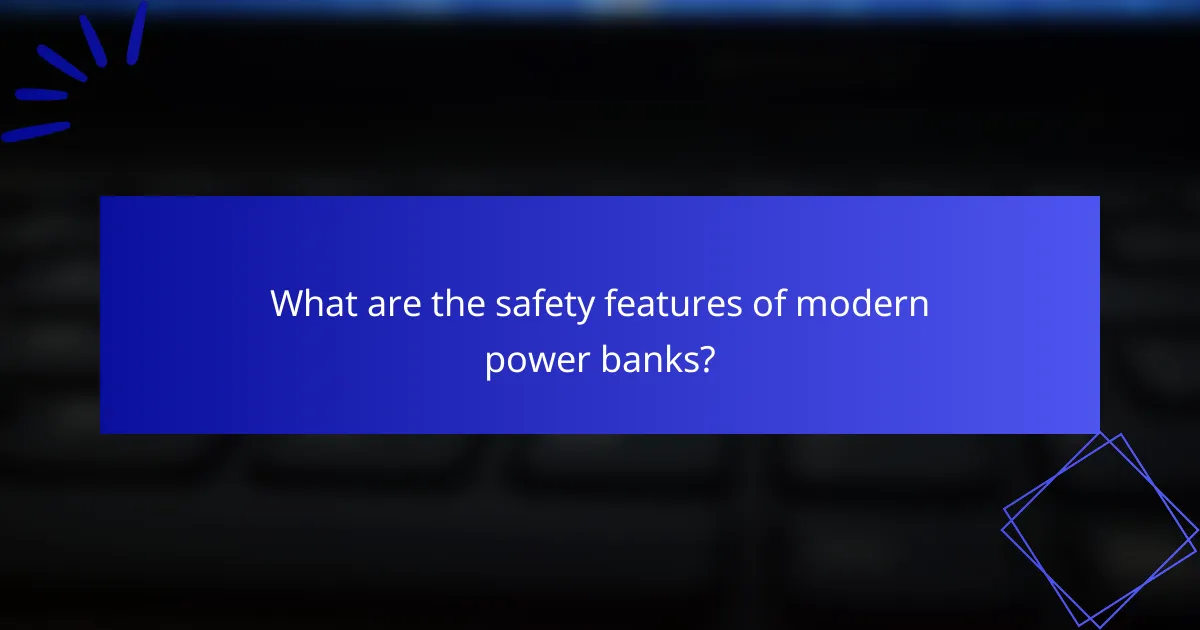
What are the safety features of modern power banks?
Modern power banks are equipped with several safety features designed to protect both the device and the user. These features include overcharge protection and short circuit prevention, which help to ensure safe charging and usage.
Overcharge protection
Overcharge protection prevents the power bank from supplying power once the connected device’s battery is fully charged. This feature is crucial as it helps to avoid battery damage and prolongs the lifespan of both the power bank and the device being charged.
Typically, power banks utilize built-in circuitry that detects when a device reaches full charge, automatically stopping the flow of electricity. Users should look for power banks that comply with safety standards such as UL or CE, which indicate reliable overcharge protection.
Short circuit prevention
Short circuit prevention is a critical safety feature that protects against electrical faults that can cause overheating or fires. This feature ensures that if a short circuit occurs, the power bank will immediately cut off power to prevent damage.
Most modern power banks incorporate fuses or circuit breakers that activate in the event of a short circuit. When selecting a power bank, it is advisable to choose models that highlight this feature, as it significantly enhances user safety and device reliability.






